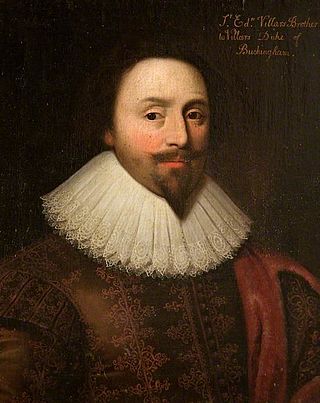
Walter Hungerford, 1st Baron Hungerford was an English knight and landowner, from 1400 to 1414 a Member of the House of Commons, of which he became Speaker, then was an Admiral and peer.

Sir Thomas de Hungerford of Farleigh Castle in Somerset, was the first person to be recorded in the rolls of the Parliament of England as holding the office of Speaker of the House of Commons of England, although that office had existed before his tenure.

This is a list of the sheriffs and high sheriffs of Wiltshire.

Sir John St John, 1st Baronet of Lydiard Tregoze in the English county of Wiltshire, was a Member of Parliament and prominent Royalist during the English Civil War. He was created a baronet on 22 May 1611.
Anthony Hungerford of Black Bourton (1607/08–1657), was an English Member of Parliament who supported the Royalist cause during the English Civil War.

Sir Edward Hungerford, KB, was an English politician who sat in the House of Commons between 1659 and 1702. He was famous for his profligate ways and sold thirty manors, including the family seat at Farleigh Hungerford, to fund his extravagant lifestyle. He founded Hungerford Market at Charing Cross as a commercial venture.
Walter Hungerford, 1st Baron Hungerford of Heytesbury, was created Baron Hungerford of Heytesbury in 1536.
Anne Basset was an English lady-in-waiting of the Tudor period, reputed to have been the mistress of King Henry VIII.

Sir Edward Villiers was an English nobleman from Leicestershire and member of the Villiers family, whose younger half-brother George Villiers, 1st Duke of Buckingham, was a favourite of both James VI and I and his son Charles. Through his influence, Sir Edward gained various positions, including Master of the Mint, Member of Parliament for Westminster and Lord President of Munster. He died in Ireland in September 1626.

Farleigh Hungerford Castle, sometimes called Farleigh Castle or Farley Castle, is a medieval castle in Farleigh Hungerford, Somerset, England. The castle was built in two phases: the inner court was constructed between 1377 and 1383 by Sir Thomas Hungerford, who made his fortune as steward to John of Gaunt. The castle was built to a quadrangular design, already slightly old-fashioned, on the site of an existing manor house overlooking the River Frome. A deer park was attached to the castle, requiring the destruction of the nearby village. Sir Thomas's son, Sir Walter Hungerford, a knight and leading courtier to Henry V, became rich during the Hundred Years War with France and extended the castle with an additional, outer court, enclosing the parish church in the process. By Walter's death in 1449, the substantial castle was richly appointed, and its chapel decorated with murals.

Sir Edward Hungerford (1596–1648) of Corsham, Wiltshire and of Farleigh Castle in Wiltshire, Member of Parliament, was a Parliamentarian commander during the English Civil War. He occupied and plundered Salisbury in 1643, and took Wardour and Farleigh castles.

Sir Anthony Hungerford (1567–1627) of Black Bourton in Oxfordshire, Deputy Lieutenant of Wiltshire until 1624, was a member of parliament and a religious controversialist.

Robert Hungerford, 3rd Baron Hungerford was an English nobleman. He supported the Lancastrian cause in the War of the Roses. In the late 1440s and early 1450s he was a member of successive parliaments. He was a prisoner of the French for much of the 1450s until his mother arranged a payment of a 7,966l ransom. In 1461, after defeat on the Towton battlefield on 29 March, he fled with Henry VI to Scotland. In 1461 he was attainted in Edward IV's first parliament, and executed in Newcastle soon after he was captured at the Battle of Hexham.

Sir Thomas Hungerford of Rowden was an English nobleman. He supported the Lancastrian cause in the War of the Roses and was executed for supporting a conspiracy to restore Henry VI.
Sir Walter Hungerford of Farleigh fought for Henry VII at the Battle of Bosworth. He served on the Privy Council for both Henry VII and Henry VIII.

Robert Hungerford, 2nd Baron Hungerford (1409–1459) was an English landowner. The second but eldest surviving son of Walter Hungerford, 1st Baron Hungerford, he served in the Hundred Years' War, and was summoned to parliament as Baron Hungerford from 5 September 1450 to 26 May 1455. He died 14 May 1459, and in accordance with his will was buried in Salisbury Cathedral. He was succeeded by his son Robert Hungerford, 3rd Baron Hungerford (1431–1464).
Agnes, Lady Hungerford was a murderer and the second wife of Sir Edward Hungerford. When he died in 1522, Agnes was then charged and convicted of the murder of her first husband, John Cotell. She was hanged at Tyburn in 1523.
Anne, Lady Hungerford was an English lady of the royal court during the reign of Queen Mary I, and poet.
Sir Edward Hungerford was an English landowner and politician who sat in the House of Commons in 1601.
Sir Edward Hungerford, was a soldier and courtier in the court of King Henry VIII of England who was present at the Field of the Cloth of Gold in 1520.













